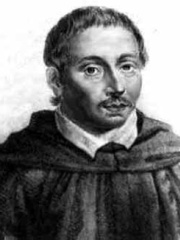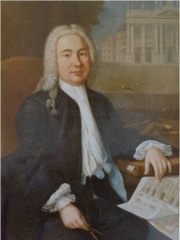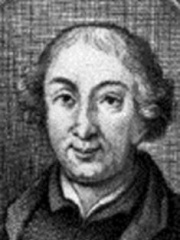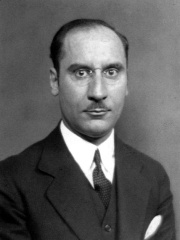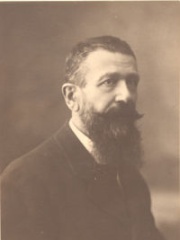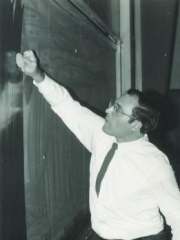
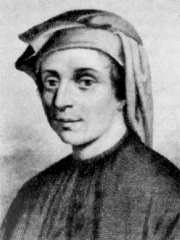
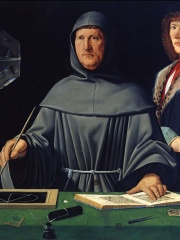
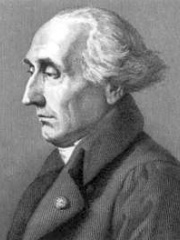
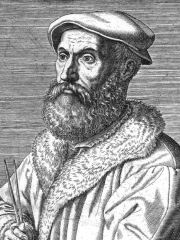
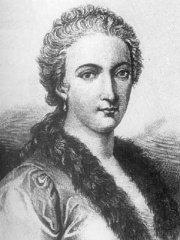
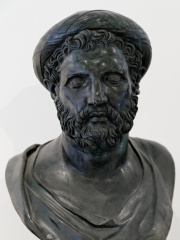
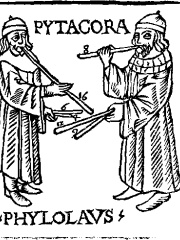
The Most Famous
MATHEMATICIANS from Italy
This page contains a list of the greatest Italian Mathematicians. The pantheon dataset contains 1,004 Mathematicians, 63 of which were born in Italy. This makes Italy the birth place of the 6th most number of Mathematicians behind United States, and Russia.
Top 10
The following people are considered by Pantheon to be the top 10 most legendary Italian Mathematicians of all time. This list of famous Italian Mathematicians is sorted by HPI (Historical Popularity Index), a metric that aggregates information on a biography’s online popularity. Visit the rankings page to view the entire list of Italian Mathematicians.

1. Archimedes (-287 - -212)
With an HPI of 89.76, Archimedes is the most famous Italian Mathematician. His biography has been translated into 179 different languages on wikipedia.
Archimedes of Syracuse (, ARK-ihm-EE-deez; c. 287 – c. 212 BC) was an Ancient Greek mathematician, physicist, engineer, astronomer, and inventor from the ancient city of Syracuse in Sicily. Although few details of his life are known, he is regarded as one of the leading scientists in classical antiquity. Considered the greatest mathematician of ancient history, and one of the greatest of all time, Archimedes anticipated modern calculus and analysis by applying the concept of the infinitely small and the method of exhaustion to derive and rigorously prove a range of geometrical theorems. These include the area of a circle, the surface area and volume of a sphere, the area of an ellipse, the area under a parabola, the volume of a segment of a paraboloid of revolution, the volume of a segment of a hyperboloid of revolution, and the area of a spiral.Archimedes' other mathematical achievements include deriving an approximation of pi, defining and investigating the Archimedean spiral, and devising a system using exponentiation for expressing very large numbers. He was also one of the first to apply mathematics to physical phenomena, working on statics and hydrostatics. Archimedes' achievements in this area include a proof of the law of the lever, the widespread use of the concept of center of gravity, and the enunciation of the law of buoyancy known as Archimedes' principle. He is also credited with designing innovative machines, such as his screw pump, compound pulleys, and defensive war machines to protect his native Syracuse from invasion. Archimedes died during the siege of Syracuse, when he was killed by a Roman soldier despite orders that he should not be harmed. Cicero describes visiting Archimedes' tomb, which was surmounted by a sphere and a cylinder that Archimedes requested be placed there to represent his mathematical discoveries. Unlike his inventions, Archimedes' mathematical writings were little known in antiquity. Mathematicians from Alexandria read and quoted him, but the first comprehensive compilation was not made until c. 530 AD by Isidore of Miletus in Byzantine Constantinople, while commentaries on the works of Archimedes by Eutocius in the 6th century opened them to wider readership for the first time. The relatively few copies of Archimedes' written work that survived through the Middle Ages were an influential source of ideas for scientists during the Renaissance and again in the 17th century, while the discovery in 1906 of previously lost works by Archimedes in the Archimedes Palimpsest has provided new insights into how he obtained mathematical results.

2. Fibonacci (1170 - 1240)
With an HPI of 79.36, Fibonacci is the 2nd most famous Italian Mathematician. His biography has been translated into 113 different languages.
Fibonacci (; also US: , Italian: [fiboˈnattʃi]; c. 1170 – c. 1240–50), also known as Leonardo Bonacci, Leonardo of Pisa, or Leonardo Bigollo Pisano ('Leonardo the Traveller from Pisa'), was an Italian mathematician from the Republic of Pisa, considered to be "the most talented Western mathematician of the Middle Ages".The name he is commonly called, Fibonacci, was made up in 1838 by the Franco-Italian historian Guillaume Libri and is short for filius Bonacci ('son of Bonacci'). However, even earlier, in 1506, a notary of the Holy Roman Empire, Perizolo mentions Leonardo as "Lionardo Fibonacci".Fibonacci popularized the Indo–Arabic numeral system in the Western world primarily through his composition in 1202 of Liber Abaci (Book of Calculation) and also introduced Europe to the sequence of Fibonacci numbers, which he used as an example in Liber Abaci.

3. Luca Pacioli (1445 - 1517)
With an HPI of 75.53, Luca Pacioli is the 3rd most famous Italian Mathematician. His biography has been translated into 59 different languages.
Fra. Luca Bartolomeo de Pacioli (sometimes Paccioli or Paciolo; c. 1447 – 19 June 1517) was an Italian mathematician, Franciscan friar, collaborator with Leonardo da Vinci, and an early contributor to the field now known as accounting. He is referred to as the father of accounting and bookkeeping and he was the first person to publish a work on the double-entry system of book-keeping on the continent. He was also called Luca di Borgo after his birthplace, Borgo Sansepolcro, Tuscany. Several of his works were plagiarised from Piero della Francesca, in what has been called "probably the first full-blown case of plagiarism in the history of mathematics".

4. Joseph-Louis Lagrange (1736 - 1813)
With an HPI of 75.30, Joseph-Louis Lagrange is the 4th most famous Italian Mathematician. His biography has been translated into 88 different languages.
Joseph-Louis Lagrange (born Giuseppe Luigi Lagrangia or Giuseppe Ludovico De la Grange Tournier; 25 January 1736 – 10 April 1813), also reported as Giuseppe Luigi Lagrange or Lagrangia, was an Italian mathematician, physicist and astronomer, later naturalized French. He made significant contributions to the fields of analysis, number theory, and both classical and celestial mechanics. In 1766, on the recommendation of Swiss Leonhard Euler and French d'Alembert, Lagrange succeeded Euler as the director of mathematics at the Prussian Academy of Sciences in Berlin, Prussia, where he stayed for over twenty years, producing volumes of work and winning several prizes of the French Academy of Sciences. Lagrange's treatise on analytical mechanics (Mécanique analytique, 4. ed., 2 vols. Paris: Gauthier-Villars et fils, 1788–89), written in Berlin and first published in 1788, offered the most comprehensive treatment of classical mechanics since Newton and formed a basis for the development of mathematical physics in the nineteenth century. In 1787, at age 51, he moved from Berlin to Paris and became a member of the French Academy of Sciences. He remained in France until the end of his life. He was instrumental in the decimalisation in Revolutionary France, became the first professor of analysis at the École Polytechnique upon its opening in 1794, was a founding member of the Bureau des Longitudes, and became Senator in 1799.
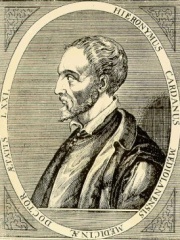
5. Gerolamo Cardano (1501 - 1576)
With an HPI of 73.98, Gerolamo Cardano is the 5th most famous Italian Mathematician. His biography has been translated into 63 different languages.
Gerolamo Cardano (Italian: [dʒeˈrɔːlamo karˈdaːno]; also Girolamo or Geronimo; French: Jérôme Cardan; Latin: Hieronymus Cardanus; 24 September 1501– 21 September 1576) was an Italian polymath whose interests and proficiencies ranged through those of mathematician, physician, biologist, physicist, chemist, astrologer, astronomer, philosopher, writer, and gambler. He became one of the most influential mathematicians of the Renaissance and one of the key figures in the foundation of probability; he introduced the binomial coefficients and the binomial theorem in the Western world. He wrote more than 200 works on science.Cardano partially invented and described several mechanical devices, including the combination lock, the gimbal consisting of three concentric rings allowing a supported compass or gyroscope to rotate freely, and the Cardan shaft with universal joints, which allows the transmission of rotary motion at various angles and is used in vehicles to this day. He made significant contributions to hypocycloids - published in De proportionibus, in 1570. The generating circles of these hypocycloids, later named "Cardano circles" or "cardanic circles", were used for the construction of the first high-speed printing presses.Today, Cardano is well known for his achievements in algebra. In his 1545 book Ars Magna he made the first systematic use of negative numbers in Europe, published (with attribution) the solutions of other mathematicians for cubic and quartic equations, and acknowledged the existence of imaginary numbers.

6. Niccolò Fontana Tartaglia (1499 - 1557)
With an HPI of 70.78, Niccolò Fontana Tartaglia is the 6th most famous Italian Mathematician. His biography has been translated into 52 different languages.
Nicolo, known as Tartaglia (Italian: [tarˈtaʎʎa]; 1499/1500 – 13 December 1557), was an Italian mathematician, engineer (designing fortifications), a surveyor (of topography, seeking the best means of defense or offense) and a bookkeeper from the then Republic of Venice. He published many books, including the first Italian translations of Archimedes and Euclid, and an acclaimed compilation of mathematics. Tartaglia was the first to apply mathematics to the investigation of the paths of cannonballs, known as ballistics, in his Nova Scientia (A New Science, 1537); his work was later partially validated and partially superseded by Galileo's studies on falling bodies. He also published a treatise on retrieving sunken ships.

7. Maria Gaetana Agnesi (1718 - 1799)
With an HPI of 70.72, Maria Gaetana Agnesi is the 7th most famous Italian Mathematician. Her biography has been translated into 67 different languages.
Maria Gaetana Agnesi (UK: an-YAY-zee, US: ahn-, Italian: [maˈriːa ɡaeˈtaːna aɲˈɲeːzi, -ɲɛːz-]; 16 May 1718 – 9 January 1799) was an Italian mathematician, philosopher, theologian, and humanitarian. She was the first woman to write a mathematics handbook and the first woman appointed as a mathematics professor at a university.She is credited with writing the first book discussing both differential and integral calculus and was a member of the faculty at the University of Bologna, although she never served. She devoted the last four decades of her life to studying theology (especially patristics) and to charitable work and serving the poor. She was a devout Catholic and wrote extensively on the marriage between intellectual pursuit and mystical contemplation, most notably in her essay Il cielo mistico (The Mystic Heaven). She saw the rational contemplation of God as a complement to prayer and contemplation of the life, death and resurrection of Jesus Christ.Maria Teresa Agnesi Pinottini, harpsichordist and composer, was her sister.

8. Archytas (-428 - -347)
With an HPI of 70.60, Archytas is the 8th most famous Italian Mathematician. His biography has been translated into 55 different languages.
Archytas (; Greek: Ἀρχύτας; 435/410–360/350 BC) was an Ancient Greek mathematician, music theorist, statesman, and strategist from the ancient city of Taras (Tarentum) in Southern Italy. He was a scientist and philosopher affiliated with the Pythagorean school and famous for being the reputed founder of mathematical mechanics and a friend of Plato.As a Pythagorean, Archytas believed that arithmetic (logistic), rather than geometry, provided the basis for satisfactory proofs, and developed the most famous argument for the infinity of the universe in antiquity.

9. Philolaus (-470 - -390)
With an HPI of 69.92, Philolaus is the 9th most famous Italian Mathematician. His biography has been translated into 47 different languages.
Philolaus (; Ancient Greek: Φιλόλαος, Philólaos; c. 470 – c. 385 BC) was a Greek Pythagorean and pre-Socratic philosopher. He was born in a Greek colony in Italy and migrated to Greece. Philolaus has been called one of three most prominent figures in the Pythagorean tradition and the most outstanding figure in the Pythagorean school. Pythagoras developed a school of philosophy that was dominated by both mathematics and mysticism. Most of what is known today about the Pythagorean astronomical system is derived from Philolaus's views. He may have been the first to write about Pythagorean doctrine. According to August Böckh (1819), who cites Nicomachus, Philolaus was the successor of Pythagoras.He argued that at the foundation of everything is the part played by the limiting and limitless, which combine in a harmony. With his assertions that the Earth was not the center of the universe (geocentrism), he is credited with the earliest known discussion of concepts in the development of heliocentrism, the theory that the Earth is not the center of the Universe, but rather that the Sun is. Philolaus discussed a Central Fire as the center of the universe and that spheres (including the Sun) revolved around it.
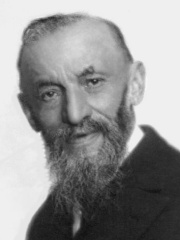
10. Giuseppe Peano (1858 - 1932)
With an HPI of 68.43, Giuseppe Peano is the 10th most famous Italian Mathematician. His biography has been translated into 55 different languages.
Giuseppe Peano (; Italian: [dʒuˈzɛppe peˈaːno]; 27 August 1858 – 20 April 1932) was an Italian mathematician and glottologist. The author of over 200 books and papers, he was a founder of mathematical logic and set theory, to which he contributed much notation. The standard axiomatization of the natural numbers is named the Peano axioms in his honor. As part of this effort, he made key contributions to the modern rigorous and systematic treatment of the method of mathematical induction. He spent most of his career teaching mathematics at the University of Turin. He also wrote an international auxiliary language, Latino sine flexione ("Latin without inflections"), which is a simplified version of Classical Latin. Most of his books and papers are in Latino sine flexione, while others are in Italian.
People
Pantheon has 69 people classified as Italian mathematicians born between 470 BC and 1999. Of these 69, 3 (4.35%) of them are still alive today. The most famous living Italian mathematicians include Enrico Bombieri, Alessio Figalli, and Pietro Boselli. The most famous deceased Italian mathematicians include Archimedes, Fibonacci, and Luca Pacioli. As of April 2024, 6 new Italian mathematicians have been added to Pantheon including Giacomo F. Maraldi, Alessandro Galilei, and Tommaso Ceva.
Living Italian Mathematicians
Go to all RankingsEnrico Bombieri
1940 - Present
HPI: 55.96
Alessio Figalli
1984 - Present
HPI: 38.89
Pietro Boselli
1988 - Present
HPI: 31.24
Deceased Italian Mathematicians
Go to all RankingsArchimedes
287 BC - 212 BC
HPI: 89.76
Fibonacci
1170 - 1240
HPI: 79.36
Luca Pacioli
1445 - 1517
HPI: 75.53
Joseph-Louis Lagrange
1736 - 1813
HPI: 75.30
Gerolamo Cardano
1501 - 1576
HPI: 73.98
Niccolò Fontana Tartaglia
1499 - 1557
HPI: 70.78
Maria Gaetana Agnesi
1718 - 1799
HPI: 70.72
Archytas
428 BC - 347 BC
HPI: 70.60
Philolaus
470 BC - 390 BC
HPI: 69.92
Giuseppe Peano
1858 - 1932
HPI: 68.43
Bonaventura Cavalieri
1598 - 1647
HPI: 67.86
Lodovico Ferrari
1522 - 1565
HPI: 62.84
Newly Added Italian Mathematicians (2024)
Go to all RankingsGiacomo F. Maraldi
1665 - 1729
HPI: 51.27
Alessandro Galilei
1691 - 1737
HPI: 49.48
Tommaso Ceva
1648 - 1737
HPI: 49.29
Leonida Tonelli
1885 - 1946
HPI: 47.23
Cesare Burali-Forti
1861 - 1931
HPI: 46.91
Gian-Carlo Rota
1999 - 1999
HPI: 18.63
Overlapping Lives
Which Mathematicians were alive at the same time? This visualization shows the lifespans of the 25 most globally memorable Mathematicians since 1700.




